
Pseudoscorpions.
It probably does little to assuage the unsavory first impressions one has with the subject of the third group featured in this blog?s arachnid series, the pseudoscorpion, by noting that its name literally means ?false?scorpion.? Perhaps this is no surprise, given that without the proper context, pseudoscorpions are intimidating both in their name and in their generally ?icky? appearance, armed with menacing claws, attached to a body that resembles a lightbulb made out of alligator skin. If nothing else, you?d at least be somewhat justified in being suspicious of them. Looks like a scorpion, has ?scorpion? right in the name, but isn?t a real scorpion? Please. Just what is that tailless son of a bitch hiding? Maybe you doubt that there is such an animal, and the photo above simply depicts a normal scorpion, sans its stinging tail, removed by Photoshop. ?What kind of rube do you take me for, blogger on the Internet?! I do not take kindly to unprovoked trickery!?, you howl, with language curiously more sophisticated than what is normal for someone so enraged.
The thing is, pseudoscorpions really?are?a unique group of arachnids distinct from ?true scorpions.? They are partitioned off from the rest of the arachnids in their own taxonomic order, the predictably-named Pseudoscorpionida (also called Chelonethida). It is thought that in the Great Arachnid Family Tree, pseudoscorpions represent one of several springy arms forking off from a massive branch known as Dromopoda, which also includes potential sister groups like harvestmen (think daddy longlegs), ?actual? scorpions (the nasty, pinchy, venomous kind), and solifugids (the infamous ?camel spiders? of Internet renown, the subject of urban legends stemming from U.S. soldiers? alleged interactions with them during the Iraq War?and a tasty snack for Bear Grylls). There is some disagreement within the scientific community about the Dromopoda division, and whether or not it is a true, monophyletic group (monophyletic meaning that it?s a defined grouping on a tree including a species and all of its descendants; for example, the grouping of ?reptiles? excludes mammals and birds, and would exhibit something known as paraphyly?however ?amniotes? includes ALL the descendants of the amniote common ancestor (birds, lizards, mammals, snakes, turtles, etc.) and would constitute a legitimate, monophyletic taxon), but even if Dromopoda isn?t a cohesive evolutionary unit, it is still likely that pseudoscorpions, based on a combination of morphological and molecular characters, are closely allied, evolutionarily, with many of those ?Dromopodan? orders.
So yes, pseudoscorpions are kissing cousins with desert-terrorizing nightmares like scorpions and camel spiders, and those gangly, spider-lookin? things that collect as corpses in the lonely corners of your garage every summer.
Unlike with the other previously featured, underappreciated arachnid orders, hooded tickspiders and tailless whip scorpions, the reason pseudoscorpions aren?t that familiar to most folks doesn?t have origins in low species diversity, overall rarity, or being restricted to remote habitats in the wilds of the tropical zone. Pseudoscorpionida sports more than 3,000 species in over 400 genera?which is a shit load. Furthermore, additional species are being recorded all the goddamned time; one species was recently discovered right smack in the middle of arguably the busiest and boot-trampled National Park in the U.S., Yosemite National Park. Another was found lurking in a cave system in the Colorado Rockies, like some kind of tiny, lobster-clawed Gollum.
Their range is ridiculously expansive, with pseudoscorpions being described from frigid mountaintops and the Canadian north, to the equatorial jungles, to small, isolated island chains, to even, apparently, under the fucking ground. They seem to show up pretty much everywhere outside of Antarctica, which is a biogeographic trait held in common with not much else outside of bacteria?and humans.
So, what is it? If there are so many of them, and they are supposedly EVERYWHERE, why don?t we see them all the time? Why do we not have pseudoscorpions pouring into the seams of doorjams when the bite of winter descends, like we do with spiders and other domestic arthropods? Why don?t we spy them in the city park alongside butterflies and ants?
Quite frankly, a huge part of the answer is that pseudoscorpions are uniformly Lilliputian. This is in contrast with true scorpions, which have representatives that can weigh as much as a hamster. The largest species of pseudoscorpion flirt with a centimeter in length, but most species are about as long as a dime is thick. These guys could theoretically, comfortably use one of the wrinkles on your thumb knuckle as a cozy blanket. That?s right, pseudoscorpions, the Joe Pescis of the arachnid world, are wee little fuckers, hardly discernible with the naked eye. Because of this, only incredibly close observation outdoors, or a chance encounter with one crawling across an unnaturally light surface (like a painted, indoor wall), will yield an interaction with these strange arachnids.
Pseudoscorpions fairly conservatively follow the standard arachnid bauplan (four pairs of legs, two main body segments, pedipalps, chelicerae, etc.) and while most folks would describe them as ?basically a scorpion without the tail?, I think they look like someone took a termite and a crab and smashed them together, end to end.
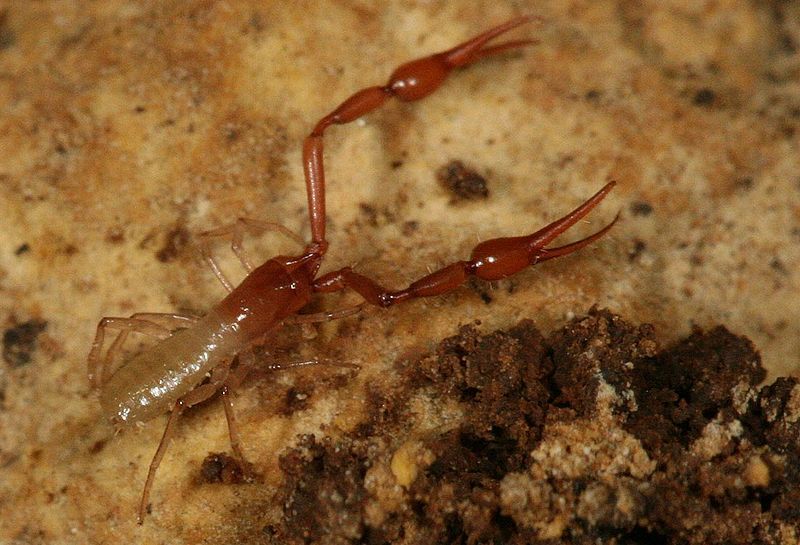
Just don?t expect this guy to sing ?Under the Sea?
It?s probably those crab-like pincers that are the stand-out characteristic of the pseudoscorpion. They are modified pedipalps, the same leg-like appendages that gave rise to true scorpion pincers, the spiked, raptorial arms of the amblypygids, and the simple ?feelers? of spiders. These pincers, and accompanying pedipalp ?arms?, are often incredibly large in proportion to the rest of the body. While their primary purpose is to pin down and immobilize prey, which consists of arthopods even smaller than themselves, these pint-sized pliers are also instrumental in getting the pseudoscorpion from place to place. Pseudoscorpions are arachnids, and do not have sensory antennae to help them navigate their environment like insects and other arthropods do; an element of life that is not assisted by the fact that pseudoscorpions, regular inhabitants of Earth?s less-than-illuminated places, have very poor eyesight, and many species are flat out blind. However, the pedipalp pincers help fill that sensory role. Most species? pedipalps (in addition to various other areas on their bodies) are covered in long bristles (called ?trichobothria?) that are highly sensitive to minute disturbances and vibrations in the air, acting like a battery of some sort of fine-tuned aerial seismographs, and help give the pseudoscorpion an idea of what the hell is in front of it, behind it, and all around it with amazing acuity. So, when a pseudoscorpion moves along, pedipalps extended far in front, these appendages act like a combination of a white cane and a Nifty Nabber.
The other, more obvious role, of the pedipalp pincers deviates away from the ?touchy-feely? and into the realm of the ?slicey-crunchy?. Make no mistake, pseudoscorpions are brutal predators, and will mercilessly slaughter whatever tender, defenseless critter that they decide is food (see: just about everything small enough). To us, a pseudoscorpion can be flung off a desk with not much more than a heavy sigh, but in the world of the very tiny, pseudoscorpions possess all the formidability of a Bengal tiger. If a wayward mite, ant, or larvae finds itself hopelessly stuck in the path of a hungry pseudoscorpion, their options are limited to a) defecating in abject terror and/or b) hastily praying to whatever god arthropods pray to that they are spared a slow death.
Such pleading for divine compassion would be fruitless, however. Death at the scissor-like hands of a pseudoscorpion is an agonizing experience for the captured prey animal. The first step the pseudoscorpion takes in slaying its meal has its roots in the anatomy of its pincers. Like a lobster?s claw, the pincer is divided into a stationary half and a mobile half, the latter of which does the actual clamping action. The mobile claw contains a venom gland and duct that runs to the pointed tip. When prey is captured in the pedipalp, the venom is promptly injected into the poor soul?s innards. This venom isn?t designed to necessarily kill the animal, just to get it to stop its pathetic struggling. Once the prey ceases trying, in vain, to escape, it is pulled towards the mouth and gnashing chelicerae, where a saliva-like fluid full of corrosive enzymes is slobbered all over its immobilized, but still very alive, body. To get an idea of what that?d be like in our big, macroscopic world, imagine a cougar attacking a deer (or human) by shooting it with a fast-acting tranquilizer dart, and then casually vomiting industrial-strength lye all over it. Lovely.
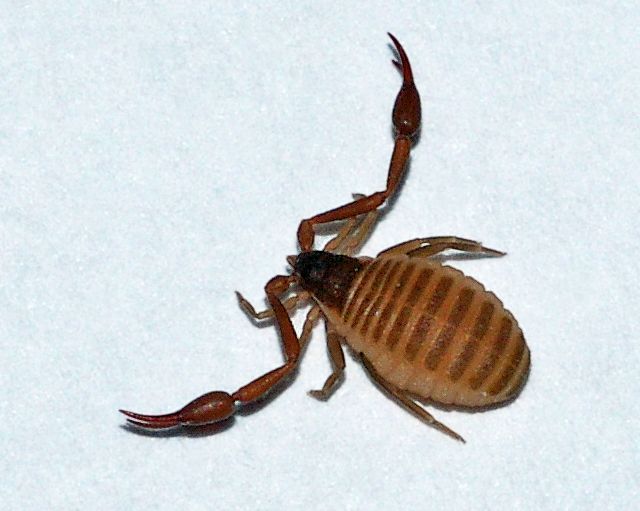
?Come on, who wants a hug??
This World?s Grisliest Act of Digestion takes place all over the globe, in many different varieties of habitats. Like I?ve previously noted, pseudoscorpions are master colonizers, having some kind of presence on just about every major and minor landmass other than Antarctica. The sun never sets on their empire, even if to us, it?s practically invisible. They are found in all the stereotypical arachnid places; wedged under tree bark or rocks, ambling around in leaf litter or soil, crouching in subterranean hollows, and even in the intertidal zone, nimbly moving around barnacles and mussels in their search for food at low tide.
They are most commonly encountered by humans indoors, and usually within the pages of an old, dusty book. On it?s face, such a fact seems a bit ludicrous. In books? Why? Pseudoscorpions can?t even fucking read.
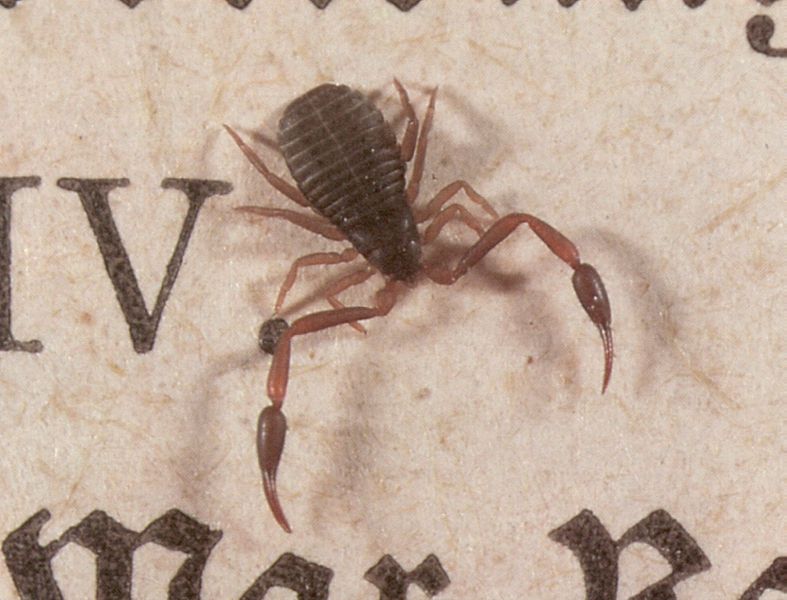
?Oh, hey man. Don?t mind me. Just finishing up some Hemingway.
It?s thought that the ?cover to cover? ecosystem is particularly attractive to pseudoscorpions due to the abundance of booklice (primitive insects of the order Psocoptera) living within the ancient, neglected tomes. Booklice, wingless, tiny, and slow, are sitting ducks in the wake of a hungry, claw-bound pseudoscorpion. Chances are, the pages of that old copy of Across Five Aprils in your bookshelf that your grandfather gave you are the site of both literary and literal bloodbaths, the inner spine festooned with enumerable, nearly microscopic, petrified carcasses of booklice, evidence of many past meals left behind by pseudoscorpions. Because booklice cause significant damage to old books, the presence of predators like pseudoscorpions routinely crawling in and culling the herd is pretty beneficial to any bibliophilic human.
Pseudoscorpions also dine on other troublesome indoor pests, like mites, and the larvae of carpet beetles?and clothes moths. By doing this, pseudoscorpions assist us in working to eradicate economically disruptive animals that are out of our reach, by being too elusive or simply too small. Screw calling the Orkin man, just let a few thousand pseudoscorpions loose in your home and call ?er good.
How is that these itty bitty critters manage to get everywhere on the planet, nevermind into every nook and cranny of your house? They can?t fly or swim across oceans, and are limited to not much more than clumsily and blindly scanning the dirt for prey.
The secret lies in a habit of theirs called ?phoresy.? Phoresy is when an animal attaches itself to another, larger animal purely for transportation. This happens a lot with other arthropods. Mites, for example, will bum a ride from place to place on much larger insects like flies or beetles. In the case of pseudoscorpions, flies and beetles are also typically used, as well as mammals. The process is pretty straight forward. A large flying insect lands nearby, and before it can take off again, the pseudoscorpion slyly edges close, clasps onto a leg, antennae, or undercarriage of the body with its mighty claws, and prepares for takeoff. The little guys manage to hang on for dear life while being propelled through the air at what is, for them, speeds comparable to a cruising commercial airliner. The intrepid voyagers eventually, either by choice, or by accidental loss of grip, skydive from their six-legged taxi into what is hopefully greener pastures, with bountiful resources.
Pseudoscorpions essentially turn any comparatively big, highly-mobile animal into an unwitting chauffeur, allowing them to glean rides across vast bodies of water and mountain ranges (or accidentally into our homes). It?s possible this ability of pseudoscorpions to stick up a claw along a fly-packed strip of tree branch, and hitchhike to places traditionally far out of their reach, is at least partially responsible for their extremely widespread distribution.
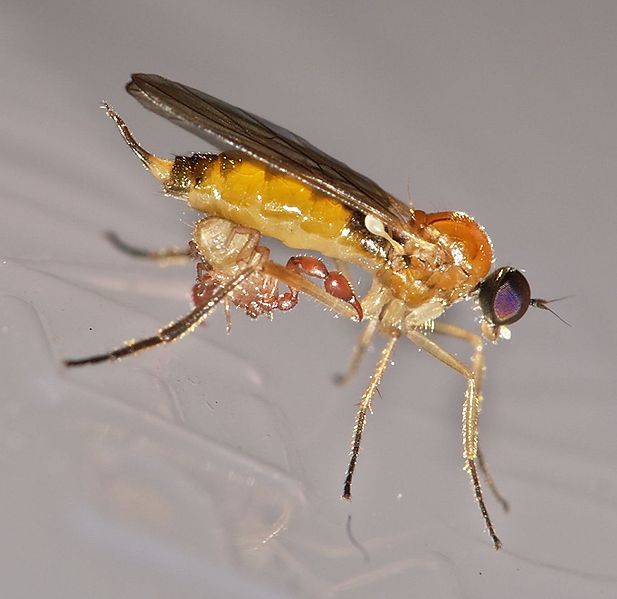
?Alright, I?m on. Let?s Christopher McCandless the fuck outta here.?
Some species can take this non-consensual carpooling to extreme levels. One example is tropical pseudoscorpions native to Central and South America that associate with rotting components of fig trees. These pseudoscorpions (as colorfully outlined in Dr. Olivia Judson?s book Dr. Tatiana?s Sex Advice to All Creation) escape the dearth of food and mate resources in their decaying, wooden home by hitching a ride on newly adult harlequin beetles (Acrocinus longimanus), emerging from the wood below. The phoretic fate of pseudoscorpions traveling this way is, on one hand, fairly traditional, with a main objective being the ultimate arrival at fresh logs with lots of food and shelter. However, since as many as two dozen pseudoscorpions, of both sexes, can stow away on the back of a gargantuan, bulky, harlequin beetle, the brief road trip can serve a second function; procreation.
The crowded, sweaty cargo hold of an airborne harlequin beetle quickly transitions from uncomfortable, stuffy ordeal in coach, to a sexy, co-ed, party bus type of situation. The pseudoscorpions waste little time on introductions and get straight to the boning, undoubtedly much to the chagrin of their poor beetle host, which has no other choice but to wait out twenty-some inconsiderate assholes engaging in an orgy in the inaccessible, impossible-to-scrub pocket under the wings.
To get an idea of the perspective of the harlequin beetle in all of this, imagine rolling out of bed, getting into your SUV to go off to work, and as soon as you start the engine and put it into drive, a throng of horny teenagers stream out of the bushes by your driveway, and aggressively force themselves into your vehicle, where they promptly begin to disrobe and fuck like there?s no tomorrow. Any pleas for them to stop are completely ineffectual, so you do your best to concentrate on the road and drive on. Oh, and you just so happen to have the pleasure of an hour long commute to work.
Pity the harlequin beetle, completely without dignity; the first few moments of its adult life spent smothered by the sex lives of other creatures.
While in this particular case, pseudoscorpion sex can seem free-spirited, haphazard, and anonymous, without much courtship or consideration behind mating choices, this isn?t the case for most members of the order. Pseudoscorpion reproduction tends to be somewhat complicated, with many species employing elaborate mating rituals. Some species mate in a manner similar to hooded tickspiders (examined in the previous entry in this arachnid series), in which a spermatophore, after careful and delicate positioning by the male, is forcibly splattered in the female?s gonopore.
In some species of pseudoscorpion, the male produces a stalked spermatophore that fastens to the ground. Then, through a complex ?mating dance?, the male leads (and by ?leads?, I mean ?drags?) a targeted female closer and closer to where the spermatophore has been deposited. Eventually, after much insincere gallantry on the part of the male, she is positioned over the spermatophore, it is deposited inside of her, and bingo, the deed is done.
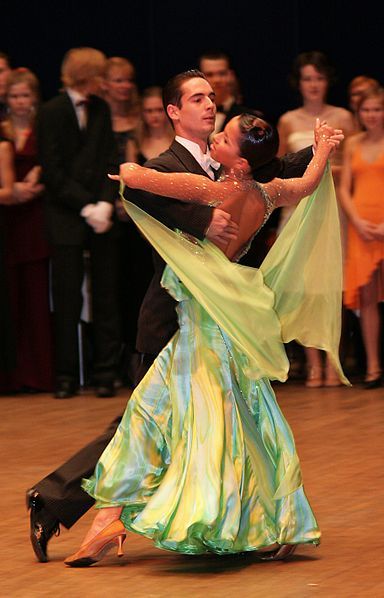
?Come on, goddamnit. Closer?closer?.clooooser??
Pseudoscorpions are the benign neighbors you?ve never heard about, dutifully hunting down indoor pests behind the scenes throughout the warmer months (and just calmly waiting out the winter by sealing themselves up in stasis inside a silken cocoon). They are to be respected for this reason, being of a unique class of arthropod predators that get rid of the things that irritate us, and yet have no capacity for harming us. Even a few representatives of their relatives, the spiders, also viewed as economically and ecologically beneficial, are very able, and willing, to hurt us. With pseudoscorpions, it?s a win-win for us.
That being said, these odd dwarves of the arachnid world, are inarguably sociopathic moochers. They remorselessly latch onto other hapless animals for free transportation (and NEVER pay for gas), they copulate wherever they please without any consideration of restraint, and the males have, at best, coercive sexual behaviors. Actually, that description sounds disturbingly similar to acquaintances from my college years?
Anyways, pseudoscorpions are harmless to humans, and provide a net benefit in our day to day lives. But from the point of view of just about anything with antennae and an exoskeleton, these manipulative, Napoleonic pricks are a scourge, ?blessed? with talents in all realms of douchebaggery and general dickishness. Whether it?s a venomous pincer suddenly lancing your body cavity, or the drone of an obnoxiously condescending lecture inspired by a year spent vacationing in the pages of Kant?s ?Critique of Pure Reason?, pseudoscorpions are a pain in the ass of a great many of the littler members of the animal kingdom.
Image credits: Introductory image, 2nd pseudoscorpion, 3rd pseudoscorpion, pseudoscorpion in book, phoretic pseudoscorpion on fly, dancers
? Jacob Buehler and ?Shit You Didn?t Know About Biology?, 2012-2013. Unauthorized use and/or duplication of this material without express and written permission from this blog?s author and/or owner is strictly prohibited. Excerpts and links may be used, provided that full and clear credit is given to Jacob Buehler and ?Shit You Didn?t Know About Biology? with appropriate and specific direction to the original content.
Like this:
Loading...
Source: http://sydkab.wordpress.com/2013/05/13/arachnids-pseudoscorpions/
brandy michael pineda charles taylor boston bruins carl crawford mad cow disease rampart
No comments:
Post a Comment